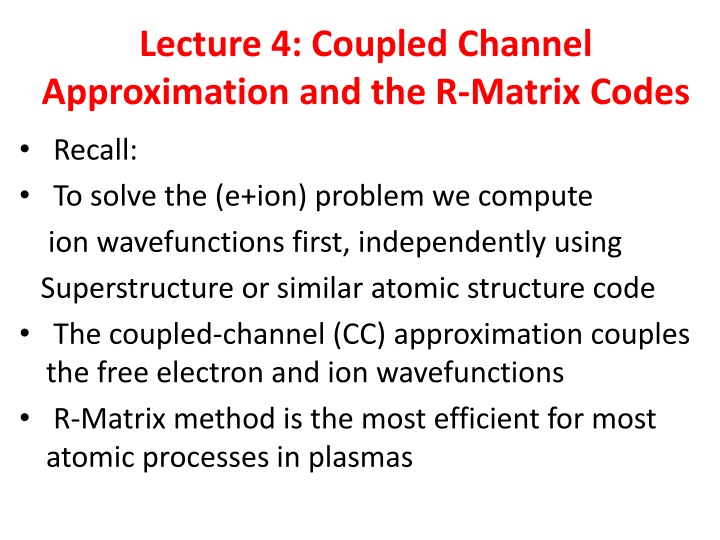
Efficient Atomic Process Modeling with Coupled-Channel Approximation
Explore the efficient use of the coupled-channel approximation and R-Matrix method in solving electron-ion interactions, from computing ion wavefunctions to diagonalization of the Hamiltonian for various atomic processes in plasmas. Dive into the stages and flow chart of R-Matrix codes, as well as the asymptotic R-Matrix codes and their role in calculating electron-ion cross sections and energy levels. Understand the significance of these methods in astrophysical studies and atomic parameter modeling.
Download Presentation

Please find below an Image/Link to download the presentation.
The content on the website is provided AS IS for your information and personal use only. It may not be sold, licensed, or shared on other websites without obtaining consent from the author. If you encounter any issues during the download, it is possible that the publisher has removed the file from their server.
You are allowed to download the files provided on this website for personal or commercial use, subject to the condition that they are used lawfully. All files are the property of their respective owners.
The content on the website is provided AS IS for your information and personal use only. It may not be sold, licensed, or shared on other websites without obtaining consent from the author.
E N D
Presentation Transcript
Lecture 4: Coupled Channel Approximation and the R-Matrix Codes Recall: To solve the (e+ion) problem we compute ion wavefunctions first, independently using Superstructure or similar atomic structure code The coupled-channel (CC) approximation couples the free electron and ion wavefunctions R-Matrix method is the most efficient for most atomic processes in plasmas
Stages of the R-Matrix Codes Superstructure (SS) one-electron orbitals (sspnl), optmized over target ion wavefunctions One and two-electron Slater integrals SS (sspnl) STG1 Angular algebra: STG2 reconstructs the target ion and couplings for the (e+ion) system STG1 STG2 (non-relativistic LS coupling) STG2 RECUPD: Intermediate re-coupling LS LSJ (Breit-Pauli approximation) RECUPD STGH: (e+ion) Hamiltonian Diagonalization
Flow Chart: Sets of R-Matrix Codes Non-relativistic R-Matrix and relativistic Breit- Pauli R-Matrix (BPRM): LS and LSJ coupling R-Matrix II codes: Complete (e+ion) angular treatment; large number of levels Dirac R-Matrix Codes (DARC): Use GRASP for target ion wavefunctions for high-Z systems Fig. 3.9 Flow chart
Asymptotic R-Matrix Codes Following (e+ion) hamiltonian diagonalization, STGH produces an H.DAT file which is utilized by subsidiary codes to calculate: electron-ion cross sections (STGF) (e+ion) bound state energy levels (STGB) bound-bound transition probabities (STGBB) bound-free (photoionization) cross sections (STGBF)
Astrophysical Quantities Absorption oscillator strengths and photoionization cross sections Opacities Line emissivities Emission Line Diagnostics All atomic parameters Non-LTE radiative transfer models
